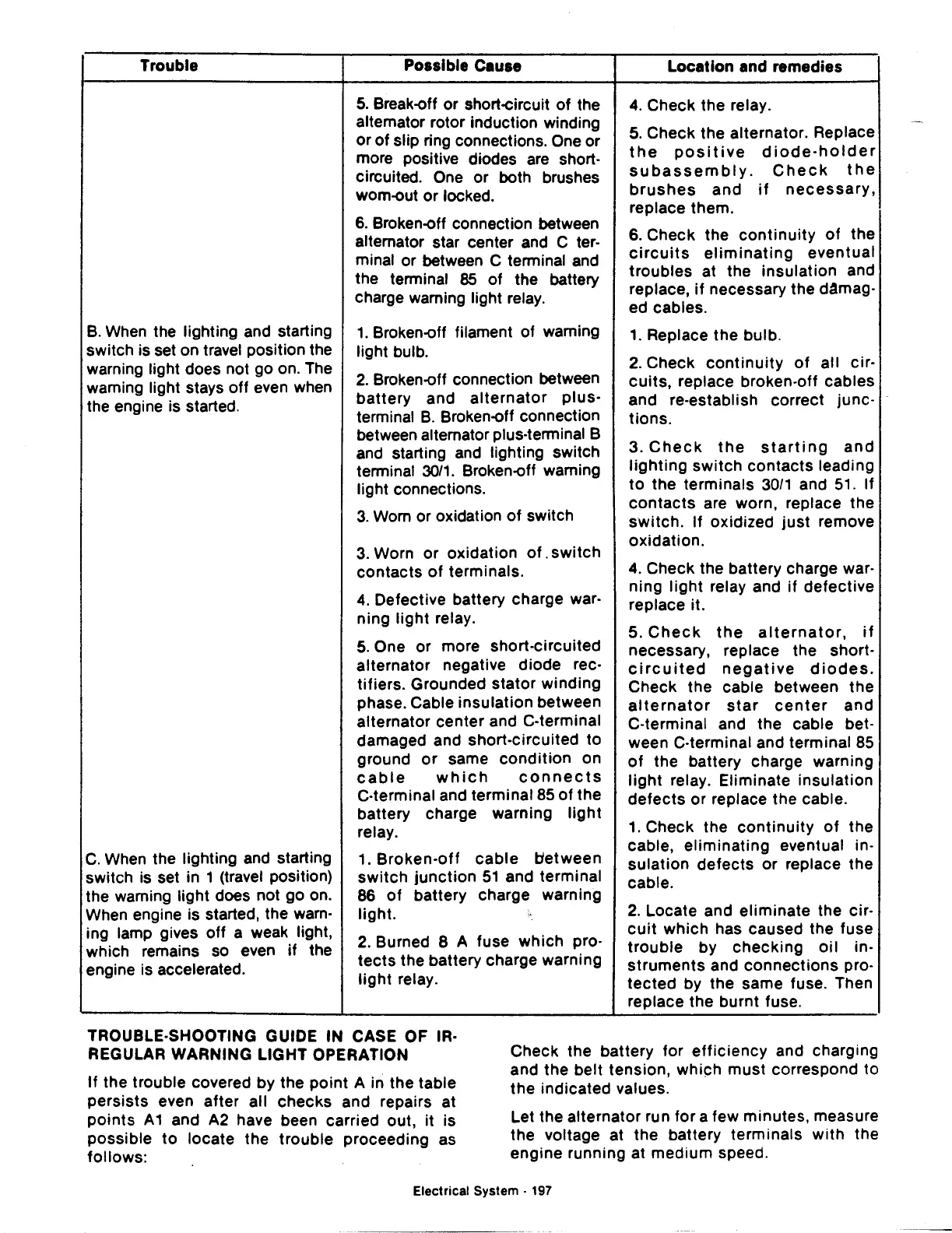Trouble
B.
When the lighting and starting
switch is set on travel position the
warning light does
not
go on. The
warning light stays
off
even when
the engine is started.
C.
When the lighting and starting
switch is set in 1 (travel position)
the warning light does
not
go
on.
When engine is started, the warn·
ing lamp gives
off
a weak light,
which remains
so
even
if
the
engine is accelerated.
Possible Cause
5.
Break-off
or
short-circuit
of
the
alternator rotor induction winding
or
of
slip ring connections. One
or
more positive diodes are short·
circuited. One
or
both brushes
worn-out
or
locked.
6.
Broken-off connection between
alternator star center and C ter-
minal
or
between C terminal and
the terminal
85
of
the battery
charge warning light relay.
1.
Broken-off filament
of
warning
light bulb.
2.
Broken-off connection between
battery
and
alternator
plus·
terminal
B.
Broken-off connection
between alternator plus-terminal B
and starting and lighting switch
terminal
30/1.
Broken-off warning
light connections.
3.
Worn
or
oxidation
of
switch
3. Worn
or
oxidation
of.
switch
contacts
of
terminals.
4.
Defective battery
charge
war·
ning
light
relay.
5.
One
or
more
short-circuited
alternator
negative
diode
rec-
tifiers.
Grounded
stator
winding
phase. Cable
insulation
between
alternator
center
and
C-terminal
damaged and
short-circuited
to
ground
or
same
condition
on
cable
which
connects
C·terminal and
terminal
85
of
the
battery
charge
warning
light
relay.
1.
Broken-off
cable
t7etween
switch
junction
51
and
terminal
86
of
battery
charge
warning
light.
.
2. Burned 8 A fuse
which
pro-
tects
the
battery
charge
warning
light
relay.
Location and remedies
4.
Check
the
relay.
5.
Check
the
alternator.
Replace
the
positive
diode-holder
subassembly.
Check
the
brushes
and
if
necessary,
replace
them.
6.
Check
the
continuity
of
the
circuits
eliminating
eventual
troubles
at
the
insulation
and
replace,
if
necessary
the
damag-
ed
cables.
1.
Replace
the
bulb.
2.
Check
continuity
of
all
cir·
cuits,
replace
broken-off
cables
and
re-establish
correct
june·
tions.
3.
Check
the
starting
and
lighting
switch
contacts
leading
to
the
terminals
30/1
and 51.
If
contacts
are worn, replace
the
switch.
If
oxidized
just
remove
oxidation.
4.
Check
the
battery
charge war-
ning
light
relay and
if
defective
replace it.
5.
Check
the
alternator,
if
necessary, replace the
short·
circuited
negative
diodes.
Check
the
cable
between
the
alternator
star
center
and
C-terminal and
the
cable
bet·
ween C-terminal and
terminal
85
of
the
battery charge
warning
light
relay.
Eliminate
insulation
defects
or
replace the cable.
1.
Check
the
continuity
of
the
cable,
eliminating
eventual
in·
sulation
defects
or
replace
the
cable.
2.
Locate
and
eliminate
the
cir·
cuit
which
has caused the fuse
trouble
by
checking
oil
in·
struments
and
connections
pro·
tected
by
the
same
fuse. Then
replace
the
burnt
fuse.
TROUBLE-SHOOTING GUIDE IN CASE OF IR·
REGULAR WARNING LIGHT OPERATION
If
the
trouble
covered
by
the
point
A in
the
table
persists
even
after
all
checks
and repairs at
points
A 1
and
A2 have been
carried
out,
it
is
possible
to
locate
the
trouble
proceeding
as
follows:
Check
the
battery
for
efficiency
and charging
and
the
belt
tension,
whi~h
must
correspond
to
the
indicated
values.
Let
the
alternator
run
for
a
few
minutes,
measure
the
voltage at
the
battery
terminals
with
the
engine
running
at
medium
speed.
Electrical System ·
197
